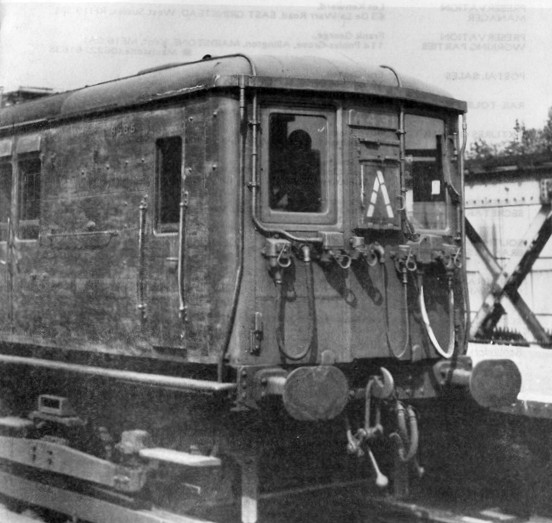
 |
From the front cover of LR107,
credited to Hugh Hughes |
3-car motor units Following the lead of the LBSCR another Southern Railway constituent company, the London and South Western Railway (LSWR), launched a scheme to electrify its suburban routes to Wimbledon via East Putney, the Kingston and Hounslow loops and branches to Shepperton, Hampton Court and Claygate on the 600V d.c. third rail system. Electric services started in 1915-16, using 84 3-car motor units, converted from existing steam-hauled rolling stock and comprising two motor coaches, each with a driving compartment and guard/luggage area, flanking a trailer. At peak times, two units operated together, sometimes with a 2-car trailer set between them. It is not obvious why this operationally awkward format was chosen in preference to 4-car units - possibly platforms on some routes were not long enough for 8-car trains. Third rail d.c. electrification, with trains operated by 3-car motor units and 2-car trailer sets, was adopted as the standard for the Southern Railway's rapidly expanding suburban network in the years up to the Second World War. Each electrification project had to comply with strict financial criteria laid down by the company's redoubtable General Manager, Sir Herbert Walker. Apart from 55 all-new units delivered in 1925-6 and some reconstructions of former LBSCR a.c. stock, all pre-war 3-car motor units were constructed using bodywork from existing steam-hauled rolling stock from all three of the Southern's principal constituent companies. These bodies were cut and spliced as necessary and mounted on SR standard electric multiple unit underframes with newly-fabricated driving cabs and guard/luggage van areas. The original LSWR units were also rebuilt on to SR standard underframes during the 1930s. Each motor coach had a powered bogie at the outer end, each with two 'type 339' motors that drove the two axles through gearwheels. Electro-magnetic contactor control gear was mounted in cabinets at the back of the motorman's compartment. British Westinghouse supplied the original equipment for the LSWR fleet and Metropolitan Vickers the SR units. In 1936 the Southern Railway switched suppliers to English Electric, who used underfloor-mounted electro-pneumatic control gear and this were fitted to the final six 3-car motor units. The two types of control gear were fully compatible with each other so units with earlier and later equipment were able to operate in multiple with each other without restriction. The units had two-pipe Westinghouse automatic air brakes, with a compressor and main reservoir on each motor coach. With the exception of small First-class saloons in some of the original LSWR cars, all passenger accommodation was in compartments with no connecting corridor. The wide range of donor vehicles led to some variations in internal layout. Typically the motor coaches had seven or eight Third-class compartments and the central trailer had five First- and four Third-class compartments. A substantial minority of units, however, had some First-class accommodation at the inner end of one motor coach and the remainder at the adjacent end of the trailer. The original LSWR 3-car motor units (and a further build of 26 all-new units built in 1925 for extensions to Guildford via Claygate and to Effingham/Dorking North via Epsom) had distinctive bull-nosed front ends but from 1926 the Southern standardised on a three-panel cab design (pictured above) with two windows either side of a central light-box which could display a stencil headcode denoting the route. As well as a screw coupler and hook on the front buffer-beam, air hoses were fitted at buffer level and control, lighting and power jumper cables were mounted on the lower front panels to enable units to work in multiple. By 1939 the Southern had a fleet of 466 three-car motor units:
2-car trailer sets Between 1920 and 1923 the LSWR made up 24 trailer sets for use between 3-car motor units to enable 8-car trains to operate on some peak services. Existing locomotive-hauled stock was converted by fitting the outer ends of the sets with buffers, screw couplings, air hoses and jumper cables for connecting to the motor units. Westinghouse two-pipe air brakes with auxiliary reservoirs and brake cylinders were fitted to each car. Conduits along the roofs carried cabling for power, control and lighting circuits. Power for heating and lighting and compressed air for the brake reservoirs were supplied from motor units. The Southern Railway went on to make up a further 188 2-car trailer sets. Most of the cars in these sets were, like the LSWR fleet, minimal conversions of existing stock on their original short underframes but 123 had rebuilt bodies on standard (or almost standard) underframes:
Augmentation As the trailer sets had neither power nor driving positions they had to be shunted into place by a motor unit, a time-consuming, operationally awkward and inflexible process. From 1942 to 1949, the Southern Railway progressively phased out the use of these trailer sets, augmenting the majority of 3-car motor units to four cars and, in parallel, building new 4-car units for suburban services. Other surviving 3-car motor units and, later, some of the augmented units, were rebuilt with new bodies on their standard underframes. Both the new and the existing augmented units were classified 4 Sub and were used interchangeably throughout the suburban network. |